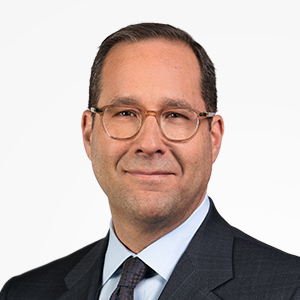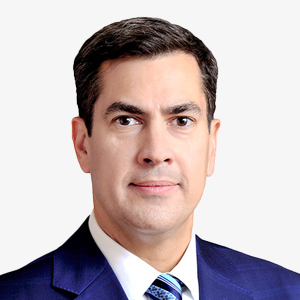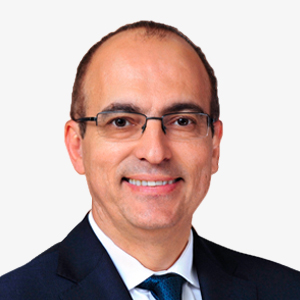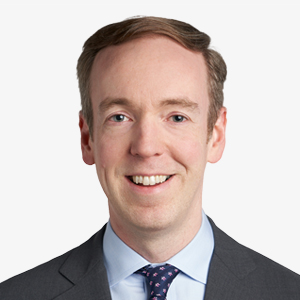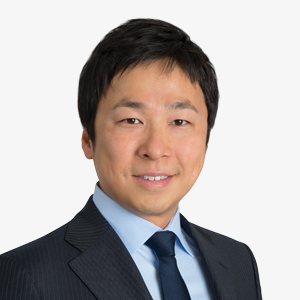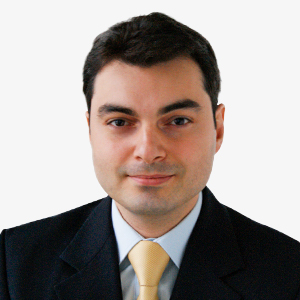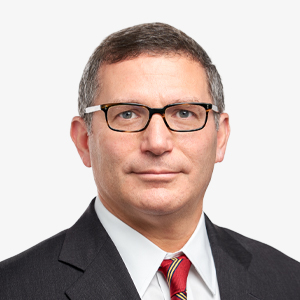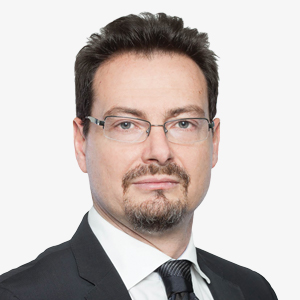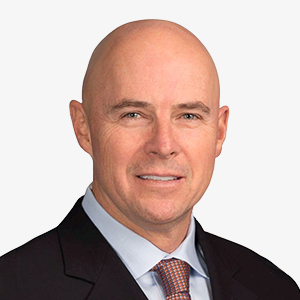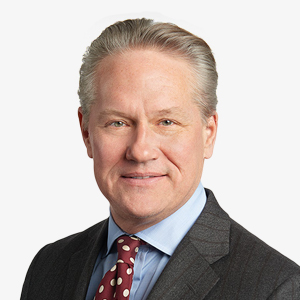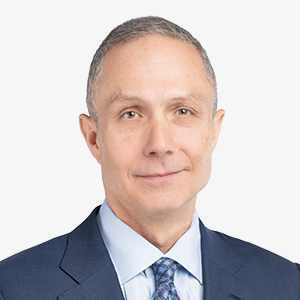Asset Allocation Committee Outlook
—Erik L. Knutzen, CFA, CAIA, Chief Investment Officer—Multi-Asset Class
The economy is starting to feel the lagged effects of tighter monetary policy. It is most visible in the current stresses in the banking system, which are tightening financial conditions still further. We think this has brought us close to the peak in the rate-increase cycle. Together with the cash held aside by institutional investors during 2022, this may explain why equity markets have performed better than we expected so far this year, and why mega-cap growth stocks have led that performance over the most recent weeks. The Asset Allocation Committee (“the AAC” or “the Committee”) does see an opportunity to start planning a journey back to a more neutral stance on risky assets in public markets, but we remain cautious on equities, anticipating volatility as we await the full impact of peak rates. In the meantime, cash and certain pockets of fixed income offer both returns and optionality. Just as important, we favor value and quality as well as regional and size diversity for the new cycle, not the U.S. large-cap growth stocks that led the last cycle and have outperformed recently; the cycle is turning, but we do not believe it is turning as sharply as the market expects, or that we are going back to the era of low inflation and low rates. The message is more urgent in private markets: here, we believe it is already an opportune time to act, as tightening financial conditions and banking-system stresses start to generate opportunities for providers of liquidity and capital who have access to where needs are greatest.
In our last Asset Allocation Outlook, we looked ahead to 2023 through a macroeconomic lens focused on a handful of key points.
Inflation would be surprisingly sticky, forcing policy rates higher. Growth would slow, unemployment would rise, and corporate earnings would decline. And in the shadow of the recent market failures in U.K. gilts and gilt repurchase agreements, we warned that the lagging impact of tighter policy would raise the risk of breakages in the system.
Job markets in the developed economies have remained strong, but otherwise these macroeconomic views have so far proven sound.
As such, we anticipated further yield-curve inversion. We thought the decline in earnings would be shallow enough to leave credit defaults low for the time being, but deep enough to test the recent lows in equity markets. That led us to an overweight view on cash and investment grade bonds, a neutral view on high-yield bonds, and underweight views on all equity markets.
U.S. and European benchmark yield curves have become more inverted, defaults have remained low and credit has performed well. But equity markets have also performed well, and beyond our expectations. The MSCI All Country World Index was up almost 10% by the end of January and finished the first quarter up 7.4%.
The Committee elected to remain underweight equities this quarter, and so the first question we asked ourselves was whether we were missing something about the current environment—something that might justify rising multiples even as earnings decline. Are we missing an opportunity to be more positive on risk?
A closer look at equity market performance suggests the outlook isn’t as positive as the headline index returns suggest. Strip out U.S. large-cap growth, and especially mega-cap technology stocks, and returns have been modest this year.
This was an outcome we did consider last quarter, when we noted the potential for re-leveraging by algorithmic trading programs, short-covering, and tactical buying of the big losing sectors from 2022.
But there may be more to it than that. Were investors taking a recessionary signal from the extreme inversion of Treasury yield curves, perhaps even anticipating the shocks to the banking system and subsequent decline in Treasury yields that occurred in March?

Credit conditions were already starting to tighten before the current stresses in the banking system, and they are now likely to deteriorate meaningfully, bringing forward central banks’ objectives on tightening financial conditions. Put simply, the tightening in credit conditions may do the central bank’s job for it and necessitate fewer rate hikes. Push that logic further and assume a return to quantitative easing as a result of this weakness, and it might make sense for technology and other growth stocks to be bid up to higher multiples than more value-oriented and cyclical stocks.
This would not be a pro-risk signal, therefore, but a pro-duration signal.
That would be a rational market response. But the AAC still thinks it is wrong.
Throughout the current policy-tightening cycle, we have been wary about how vulnerable the economy might be to the lagged impact of a rapid move to positive real rates. For many years, now, business models and financial structures have been built on foundations of negative real rates and low interest-rate volatility. The U.K.’s pooled liability-driven investment products for pension funds and Silicon Valley Bank’s deposits-to-assets duration mismatch are among the structures that have been tested to failure so far.
How might this increasingly evident vulnerability affect central banks’ inflation-fighting strategy?
We do think the disruption has shortened this rate-increase cycle. Absent a further shock, however, we still do not believe there is a strong case for pricing for U.S. rate cuts in 2023, and beyond that horizon, we think the Fed is unlikely to settle below a 3% nominal rate, or a zero real rate, over the coming cycle. While inflation is likely to decline slowly over the coming months, we believe it will ultimately settle higher than we became used to after the GFC, with greater volatility, due to structural forces of de-globalization, rising labor power and the transition to a low-carbon economy. We see little prospect of a return to anything like the zero-rate policy of the period following the Global Financial Crisis (GFC), and while the Fed’s new Bank Term Funding Program could be characterized as a “QE-lite” response to current concerns about financial fragility, we see almost no probability of a fully-fledged return to quantitative easing.
While the economic conditions have the potential to be worse than this in the eurozone, recent communications from European Central Bank (ECB) members continue to highlight that further work is required to tame inflation. We therefore believe the market is over-optimistic on rate cuts here, too.
Against this background, it’s difficult for us to see a repeat of the long period of outperformance by long-duration assets, including large-cap growth stocks, that occurred between 2009 and 2022.
Every Committee member anticipates an equity market trough this year—it’s just a question of whether there’s another leg higher to come before it happens. In the immediate term, much depends on the potential severity of the current banking stresses (see “Up for Debate: Is the Banking Crisis Over?”), the looming risks in commercial real estate and the Bank of Japan’s policy normalization, the fragility of investor sentiment, and the question of when the equity market will finally accept that rates are unlikely to be cut in 2023.
That is the main reason why our overall view on the asset class remains underweight across every category. Just as important, investors are being very well compensated to sit on the sidelines and await more certainty. Short-duration high yield bonds currently offer a yield of 9%—at a fraction of the risk associated with equities over the coming months, in our view. Short-duration investment grade is yielding around 4.9%. Attractive rates have made cash one of the Committee’s highest-conviction overweight views this quarter.
What doesn’t come across in the Committee’s current “dot plot” of asset-class views is our belief that the banking crisis has brought us close to the peak in the Fed rate-increase cycle, and that therefore we think it may be time to start planning a journey back to a more neutral stance on risky assets—even if it’s not yet time to start taking risk. This might mean identifying the equity valuation and credit-spread levels where investors would be comfortable re-entering the market as it goes through trough-formation, for example. This is another reason why we think it makes sense to remain liquid right now, in short-duration fixed income and cash.
Furthermore, when the AAC is ready to upgrade its views on equities, it is almost certainly not going to favor the U.S. large-cap technology growth stocks that have led markets so far this year. Given our long-term views on inflation and rates, we believe a structural bias to value and quality as well as regional and size diversification is more likely to suit the next cycle than the U.S. large-cap growth stocks that benefitted from the last cycle.
In private equity and debt markets, the Committee’s views are more urgent. We believe now is an opportune time to deploy capital selectively, and our views have been strengthened by the recent banking-sector stresses and the consequent tightening of credit conditions. (A downgrade for our view on private real estate reflects highly divergent prospects for different sectors of that market—see “Up for Debate: Opportunity Set or Bear Trap?”.)
We continue to believe this stage of a cycle is generally the most attractive time to make private equity commitments. While declining rates may not drive multiple expansion to the extent that it did in the last cycle, investments made during a downturn still have the advantage of starting from a relatively low base.
Within private equity, we think secondaries is the most attractive opportunity right now. Pricing on legacy assets that investors intend to hold are likely to be marked down quite modestly, as owners ride-out the downturn—but there is not the same coyness in the secondary market. Here, pricing has become more buyer-friendly. This reflects a need for liquidity among investors, a shortage of secondaries capital and a growing shortage of the financing required to hold onto some assets (which is likely to worsen further due to the stresses in the banking system). Attractive co-investment opportunities have been appearing more frequently, too, due to the same squeeze on financing and liquidity.
Private debt and specialist capital solutions offer even more direct exposure to these dynamics. Tighter financing conditions are pushing terms and yields in favor of private direct lenders: double-digit first-lien yields from high-quality, moderately leveraged companies are increasingly available. Moreover, floating rates and a position high in capital structures provide a welcome buffer against what we consider the two major macroeconomic risks over the next six to 18 months: persistently tight monetary policy and declining corporate earnings.
We believe we are nearing the peak in the rate-hiking cycle. But a peak in rates is not necessarily a signal to take risk. The impact of higher rates comes with a lag, so the extent of that impact remains uncertain—current banking stresses could be the worst thing we see or just the start. As long as investors are being well compensated for staying liquid on the sidelines, we believe it makes sense to remain cautious—while planning the journey back onto the field.
March 2023 saw the emergence of problems in some parts of the banking system.
In simplified terms, these problems arose because many banks now have unusually large holdings of government bonds, bought at very high prices: buying government bonds was often the most efficient way to use the flood of deposits received due to the fiscal and quantitative-easing response to the COVID-19 pandemic, which was far too great to extend as new loans. Over recent months, the rate being paid on deposits rose above the income being earned on long-dated government bonds being held as assets; and, as depositors left in search of higher rates from competitors and money markets, banks were forced to liquidate bond assets at substantial losses.
Silicon Valley Bank (SVB) and Credit Suisse have been the most high-profile casualties, so far. SVB appears to have failed because a large proportion of its depositors were technology businesses that proved highly mobile; and because it removed interest rate hedges from its large holding of government bonds. These are not generally thought to be issues at many other banks. Moreover, if it is an issue at other banks, the Fed’s new Bank Term Funding Program, which offers liquidity to meet deposit withdrawals using government bonds valued at par for collateral, would appear to solve it—at least for U.S. institutions.
The fact that bank stocks remain volatile reminds us that the banking system relies heavily on confidence. Credit Suisse had been struggling for some time, but there was no fundamental reason for it to experience a run on deposits—it was ultimately brought down by a sudden collapse of confidence. And there are still concerns about some regional U.S. banks, which have been subject to lighter regulation and have built up substantial loan exposure to embattled commercial real estate assets (see “Up for Debate: Real Estate—Opportunity Set or Bear Trap?”). The Fed seems ready to support the system, but providers of risk capital to these institutions will have to be on high alert.
Committee members have differing views on how well confidence could be restored over the coming weeks.
Some think the problem has been contained. Citing the overwhelming incentive banks now have to present a confident united front, they anticipate the most positive spin possible in reporting over the coming months. In their words, we should expect a lot of “extend and pretend,” particularly in the sensitive area of corporate real estate lending. These AAC members argue that, as this lifts the cloud from markets, there is potential for equities to build, at least temporarily, on their relatively strong start to the year.
Other Committee members believe that the events of March 2023 have given new information to the market: essentially, bank deposits are more mobile than anyone suspected. It follows that participants in bank capital markets will continue to look for institutions that may be overly exposed to this risk and re-allocate accordingly, potentially leading to a rolling series of mini bank crises. For these AAC members, the Bank Term Funding Program may not be enough to restore confidence: they pointed to the market volatility that greeted ambivalent statements about deposit insurance from U.S. Treasury Secretary Janet Yellen as a potential sign of things to come. In this scenario, the likelihood is that central banks do what they can to assure markets that they will make depositors in troubled institutions whole—but a lasting solution might require a formalization of unlimited deposit insurance.
The AAC downgraded its view on private real estate from overweight to neutral, but the outlook is complex.
Some important sectors are enduring a multi-year perfect storm. The COVID-19 pandemic has fundamentally changed the structural outlook for city-center offices and inflicted lasting damage on retail, which was already being challenged by the rise of e-commerce. Now, on top of all that, the occupants of those properties face high inflation, high interest rates and rising rents. Owners may also face rising interest rates on their debt financing, rising loan-to-value ratios as property prices decline, rising vacancies—and additional trouble getting financing in the U.S., following the shock to regional banks. Valuations in many core private real estate funds are still not reflecting this new environment, in our view.
That said, real estate is a $20tn marketplace and city-center offices and retail are only two sectors in it. Other sectors are already benefitting from the same dynamics that are hurting offices and retail: flexible office spaces and residential property in second- or third-tier cities and towns are in demand as working from home becomes more popular; connectivity infrastructure sites, such as cellphone towers and datacenters, benefit from the same trends and are also critical to the 5G and 6G roll-out; and warehouses and urban “infill” sites are important parts of e-commerce infrastructure. The valuations of some of these assets may be dragged down by the market. To manage the crisis of confidence in the banking sector, we think there is likely to be an “extend and pretend” approach to stressed real estate lending over the coming months, which could mask some of the problems in the sector. Attractive primary opportunities, with valuations marked down to reflect the new environment, may begin to appear thereafter.
In the meantime, rather like in private equity, we see more realistic pricing in the secondary market, as well as more attractive pricing in high-quality assets that, in our view, reflects the need for liquidity rather than fundamentals. Similar opportunities are appearing in public Real Estate Investment Trusts (REITs), where prices are down 25 – 30% from recent peaks and at wide discounts to published net asset values. We think selectivity is required here, with an eye to sectors facing structural tailwinds rather than headwinds, high quality tenants, moderate leverage and fixed or well-hedged debt-interest exposure.



- Recent banking stresses have made us more cautious on the economy and earnings. The AAC continues to favor lower beta equity exposure and value over growth, with a defensive tilt via high-quality, income-oriented stocks. That said, we see continued potential for technical market rallies as we approach the peak in the rate-hiking cycle, and we think the time to upgrade views may be nearing.
- The AAC has upgraded its view on Japan from neutral to overweight on valuations, but remains underweight overall. Recent banking stresses have made us more cautious on the economy and earnings.
- There may now be value opportunities in commodity-exporting countries, and in Asia as China emerges from its recent COVID-19 lockdowns. Overall, however, caution on the global economy and earnings informs against seeking equity exposure in emerging markets.


- The Committee maintained its overweight view on the overall sector, and upgraded its views on U.S. TIPS, where there are now attractive real yields. We favor the short end of the curve (including cash), as current yields adequately compensate for maintaining a low-risk, “paid-to-be-patient” stance amid the current uncertainty.
- Inflation and central bank hawkishness have started to push government bond yields back up, notably in Japan since the policy change at the BoJ, but non-U.S. central banks still have some way to go to catch up with the Fed on policy tightening.
- The AAC currently sees relatively attractive spreads, but continues to favor the highest-quality issuers and short duration as the economic outlook weakens. It continues to favor high yield over equities as a way to take portfolio risk, but its view on the asset class is increasingly tactical and spread-sensitive.
- The AAC sees attractive relative yields and the potential to benefit from a softening dollar and China re-opening.


- While the AAC remains strongly positive when it comes to the supply side on commodities, there are recession risks building around the demand side.
- During the ongoing economic slowdown, the AAC sees a growing role for alternative investments that have tended to exhibit uncorrelated returns, mitigate the volatility of traditional asset classes or take advantage of that volatility; and a growing role for active management, in general. We favor strategies that are fundamentally uncorrelated (such as insurance-linked strategies, where we now also see attractive value) or seek to harvest a volatility premium (such as option putwrite strategies), or take advantage of global macro or short-term trading opportunities.
- New commitments to vintages raised at the turn of cycles and the start of economic and market downturns have historically performed well, largely due to their investments being made while equity valuations decline. We see the most attractive current opportunities in secondaries, where pricing has adjusted more than the marks for portfolio companies that investors are prepared to hold onto through the economic downturn.
- While the AAC was neutral last quarter, due to marginally less attractive relative value and refinancing risk compared with high yield, recent banking stress is likely to meaningfully improve the opportunity set as it tightens bank-financing conditions for private companies. These conditions should also add to opportunities in special situations and capital solutions.
- The sector’s inflation sensitivity is attractive as the AAC’s view increasingly favors real assets over financial assets, but recent banking stresses introduce significant additional risk in important sectors such as offices and retail. These dynamics have soured investor sentiment and there may be value opportunities already in public REITs, and to come in private markets. More structurally, we believe post-pandemic growth dynamics will continue to support key sectors such as data centers, warehouses, industrial and multi-family residential.
- While the USD always has the potential to attract haven flows and the recent correction means it no longer looks very expensive relative to interest rate differentials, there may be additional risk associated with the recent downward repricing of the Fed’s rate path, while European economic data and energy prices continue to deliver positive surprises and the currency is still overvalued based on purchasing power parity (PPP) metrics.
- European economic data and energy prices continue to deliver positive surprises, inflation remains sticky, and real rates remain close to zero, suggesting that the ECB still has further to go than the Fed in its rate-hiking cycle.
- Both PPP and real exchange rates suggest the JPY is undervalued, and although the Bank of Japan may begin to normalize policy, it is still well behind other developed-market central banks.
- Despite being undervalued in terms of PPP and interest rate differentials, and supported by recent economic data coming in better than expected, stagflation concerns are elevated as the Bank of England is hiking rates into an economic slowdown and the government is pursuing fiscal consolidation.
- The Swiss franc is still very overvalued on PPP measures, is less attractive to find carry trades as yield differentials have narrowed slightly, and has lost some of its traditional haven qualities following the failure of Credit Suisse. That said, Switzerland has a positive current account balance, and the Swiss National Bank has not ruled out further interventions in the foreign exchange markets as a secondary tool to fight inflation.
Joseph V. Amato
Erik L. Knutzen, CFA, CAIA
Ashok Bhatia, CFA
Thanos Bardas, PhD
Joseph V. Amato serves as President of Neuberger Berman Group LLC and Chief Investment Officer of Equities. He is a member of the firm’s Board of Directors and its Audit Committee. His responsibilities also include overseeing the firm’s Fixed Income and hedge fund businesses.
Previously, Joe served as Lehman Brothers’ Global Head of Asset Management and Head of its Neuberger Berman subsidiary, beginning in April 2006. From 1996 through 2006, Joe held senior level positions within Lehman Brothers’ Capital Markets business, serving as Global Head of Equity Research for the majority of that time. Joe joined Lehman Brothers in 1994 as Head of High Yield Research. Prior to joining Lehman Brothers, Joe spent ten years at Kidder Peabody, ultimately as head of High Yield Research.
He received his BS from Georgetown University and is a member of the University’s Board of Directors. He currently serves on the McDonough School of Business Board of Advisors and the Psaros Center for Financial Markets and Policy Board of Advisors. He is Co-Chair of the New York City Board of Advisors of Teach for America, a national non-profit organization focused on public education reform. He is also a Board Member of KIPP NJ, a charter school network based in Newark, NJ, which focuses on educational equity.
Ashok K. Bhatia, CFA, Managing Director, joined the firm in 2017. Ashok is Chief Investment Officer and Global Head of Fixed Income, and a member of Neuberger Berman's Partnership and Asset Allocation Committees and Fixed Income's Investment Strategy Committee. Before joining the firm, Ashok held senior investment and leadership positions in several asset management firms and hedge funds, including Wells Fargo Asset Management, Balyasny Asset Management and Stark Investments, and had investment responsibilities across global fixed income and currency markets. Ashok began his career in 1993 as an investment analyst at Morgan Stanley. He received a BA with high honors in Economics from the University of Michigan, Ann Arbor, an MBA with high honors from the University of Chicago and has been awarded the Chartered Financial Analyst designation.
Timothy F. Creedon, CFA
Tokufumi Kato, PhD
Hakan Kaya, PhD
David G. Kupperman, PhD
Ugo Lancioni
Raheel Siddiqui
Robert Surgent
Raheel Siddiqui, Managing Director, Senior Research Analyst, joined the firm in 2004. Raheel is the Senior Investment Strategist in the Neuberger Berman Global Equity Research Department. In this role he researches impending inflection points in the business cycle, risk appetite, inflation, global asset classes, US sectors, style (growth vs. value), and size to enhance fundamental stock selection and portfolio construction processes by taking advantage of emerging trends not fully appreciated by the market. His research spans finding systematic ways of distilling leading or confirming messages from macroeconomic, quantitative, derivatives data, and behavioral data as well as periodically evaluating portfolios for efficient asset allocation.
Prior to this role, Raheel was a part of Lehman Brothers US Equity Strategy Team where he co-authored over 100 strategy reports, many of which were quoted in the Wall Street Journal, Financial Times, and Barron’s. Raheel also worked as a senior member of the Corporate Development team at Monsanto for six years, where he developed industry leading and award winning approach for valuing genomics assets.
Raheel earned MS/BS degrees in Biochemical Engineering from the Indian Institute of Technology and an MBA from Columbia University. Raheel has also been published with the American Institute of Physics.
Accolades referenced are issued by independent third-parties and information regarding specific criteria for accolades is available upon request and generally may be found on such third-party’s website. Barron’s rankings are based on a proprietary formula that considers various factors: assets under management, revenues generated by advisors for their firms, and the quality of the advisors’ practices. Investment performance is not an explicit criterion because performance is often a function of each client’s appetite for risk. Third-party accolades referenced do not reflect the experiences of any Neuberger Berman client and readers should not view such information as representative of any particular client’s experience or assume that they will have a similar investment experience as any previous or existing client. Third-party accolades are not indicative of the past or future performance of any Neuberger Berman product or service.
Brad Tank
Anthony D. Tutrone
Brad Tank, Managing Director, joined the firm in 2002. Brad is Co-Chief Investment Officer and the Global Head of Fixed Income. He is a member of Neuberger Berman’s Partnership, Investment Risk, Asset Allocation Committees and Fixed Income’s Investment Strategy Committee. From inception in 2008 through 2014, Brad was also Chief Investment Officer of Neuberger Berman’s Multi-Asset Class Investment business. From 1990 to 2002, Brad was director of fixed income for Strong Capital Management in Wisconsin. He was also a member of the Office of the CEO and headed institutional and intermediary distribution. In 1997, Brad was named “Runner Up” for Morningstar Mutual Fund Manager of the Year. From 1982 to 1990, he was a vice president at Salomon Brothers in the government, mortgage and financial institutions areas. Brad earned a BBA and an MBA from the University of Wisconsin.
As previously announced, Brad Tank will transition from Co-CIO of Fixed Income to a Senior Advisor role at the end of 2024, at which time Ashok Bhatia will assume the role of sole CIO of Fixed Income.


